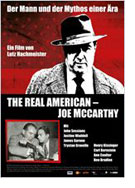

Opening 12 Jan 2012
Directed by:
Lutz Hachmeister
Writing credits:
Lutz Hachmeister, Simone Höller, Annkatrin Schiller
Principal actors:
John Sessions, Justine Waddell, Trystan Gravelle, James Garnon, Philip Bulcock
Joseph McCarthy was a U.S. senator, representing the Republican Party in the U.S. Senate in the 1950s. This docu-drama by German director Lutz Hachmeister starts with young Joe growing up, the fifth of nine children, in a relatively poor family in Wisconsin. He quits high school at age 14 to earn money, eventually gets a high school diploma in 1928 (at age 20) and studies law. He serves in the armed forces in World War II, a commitment which helps him win the election to the Senate as his opponent had not served to protect his country. In the film he is never cool and suave, but always seems to be the rough guy from the farm whom the press loves because he feeds it so much information. Along the way he marries his secretary Jean Kerr and acquires a loyal co-worker named Roy Cohn. He is most famous for flushing out supposed Communists in the State Department and other areas, such as Hollywood. In the 1950s President Eisenhower more or less gave him a long leash to pursue this goal, but never publicly supported nor denied him. In the end McCarthy became unbelievable; the press changed sides and worked against him.
The film tries to make us believe that his faithful partner, Cohn, had a homosexual affair with another co-worker named David Schine. Cohn and Schine went on a much-publicized investigative trip to Europe, but made a bad impression. By 1954 McCarthy’s star had sunk. He was still a senator, but also an alcoholic and died, probably of cirrhosis of the liver, in 1957, not yet 50 years old. Roy Cohn died of AIDS in 1986.
Hachmeister’s film is all well and good for historians, interested in U.S. politics in the 1950s. For the average film enthusiast, it is confusing. Actors perform the story, e.g., John Sessions is McCarthy, Justine Waddell is Jean Kerr, Trystan Gravelle is Roy Cohn. At the same time we see real footage of the same people, as well as interviews with real people who remember the events, such as Henry Kissinger, Ann Coulter, or Carl Bernstein. This see-sawing back and forth between real and performed events in which you have to remember who is who when each character has a doppelganger – himself and his actor – makes it difficult to follow. Perhaps you should try George Clooney’s 2005 film Good Night and Good Luck – or at least watch both of them for an interesting comparison. (Becky Tan)